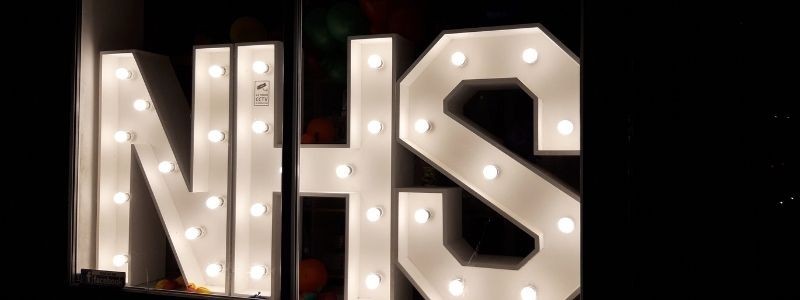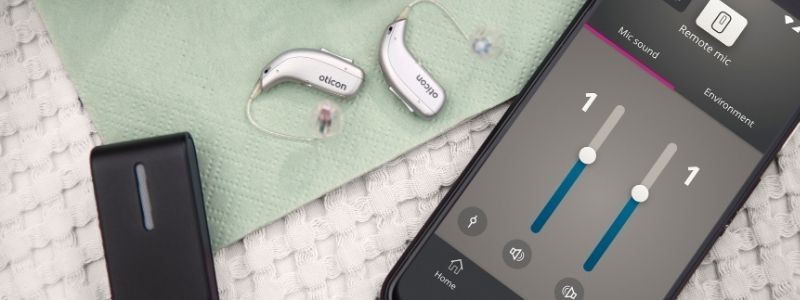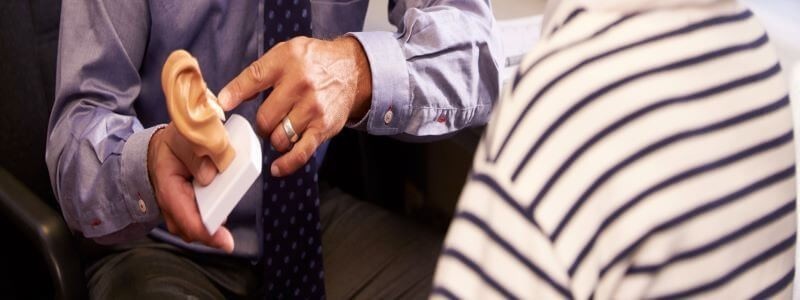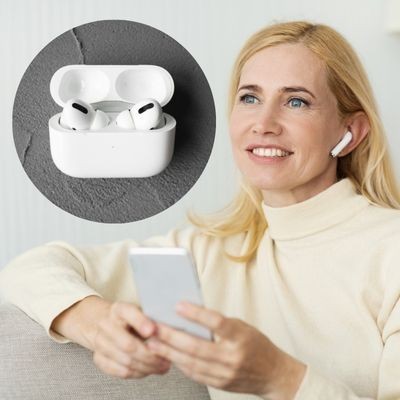
Head of Online Medical Content

Audiology Expert at Hearing Aid UK

Private Hearing Aids vs NHS
What's the difference between private hearing aids and NHS hearing aids?
Overview | Is private better? | Comparing NHS with private | NHS waiting times | Device styles | Costs | Pros and cons of NHS hearing aids | Conclusion
Should I buy a hearing aid privately?
If you are wondering whether you should buy private hearing aids or not, our founder, Paul Harrison, along with our audiologists and audiology experts go through the pros and cons of both NHS hearing aids and private hearing aids. We hope you find this information useful. Our findings are also backed up by the recent Which Report: Best hearing aid providers.
Are private hearing aids better than the NHS?
Are private hearing aids any better than NHS? Firstly, you must get any problems with your hearing checked out as soon as possible by your doctor. Even if you have already decided that you would prefer to buy hearing aids privately.
Your GP or Ear, Nose, and Throat (ENT) specialist can check your ear health and spot any treatable causes of your hearing loss, such as infection or illness.
Hearing tests are provided free on the NHS which can not only work out the level of your hearing loss but also the cause behind it. Many private hearing aid dispensers also carry out free hearing tests, but if you need treatment, you will need to see an ENT consultant.
Comparing private hearing aids and NHS hearing aids is always beneficial
A common dilemma most face, in this situation, is that due to the complexities, range, and hearing aid prices of the industry, they become more confused and exasperated before they even seek help. Perhaps due to a lack of education or contradictory advice given along the way.
Whatever the reason, we advise that you receive help from your doctor first who will discuss the NHS service.
This is the first step in discovering what hearing aid options are available to you, before opting to go private. Like with most things in life, it is always good to have comparisons, as only then will you gain from a second opinion and have the confidence to make the right decision for your hearing loss.
You'll find yourself more confident in your decision-making if you compare NHS and private hearing aids.
Private hearing aids and healthcare are personal
The recent Which Report tells us that independent audiologists were rated 86% by their patients for the service they provided, and the hearing aids purchased. In our opinion, patients from independent practices tend to feel less like a ‘number’ and more valued and cared for.
They are offered honest and unbiased advice that is bespoke to them and their hearing healthcare.
We understand that there are a few factors that may influence your decision on whether to get hearing aids privately or through the NHS - everyone is different, and what may be suitable for one person may not be right for another.

Private Hearing Aids vs NHS Hearing Aids
The Waiting Game
NHS vs private hearing aid providers and dispensers
Once you have decided to go ahead with hearing aids, are you prepared to wait, or would you rather have them sooner? The time it takes to wait for a fitting and get the mould or hearing aid made can vary between the NHS and private dispensers.
A private company can usually see you much quicker, within a week or two, for the initial test and creating a mould. Depending on the style of hearing aid you choose, you could wait between one and three weeks for your digital hearing aid to be fitted.
Whilst the NHS is reducing their waiting times, you could still wait around six weeks for your hearing test and a further six weeks for them to be fitted. This will vary depending on which part of the country you live in.
Style revolutionised
Hearing aid style is one of the major factors in choosing a hearing device. Many people are put off getting hearing aids altogether because they remember hearing aids looking big, ugly, and cumbersome. Over the years, misconceptions and stigmas about hearing aids have faded due to people receiving a better education and the topic being more talked about.
The main thing here is that the overall look and style of hearing aids have evolved and are now so discreet that they are, in some cases, invisible. People do not think twice when their eyesight dictates wearing glasses.
In fact, people wear them when they do not even need them! A fashion statement of sorts. Our attitudes have changed.
This may be due to modern, digital hearing aids being more discreet and much more powerful. The NHS provides Behind the Ear (BTE) styles, which have a small box behind the ear and a thin tube linking the box to the front of the ear.
Whilst many hearing aids use ear moulds, others can have an open fitting where the tube sits just inside the ear canal without an ear mould. This style is more discreet and harder for others to see. It also lets air circulate within the ear canal. This style is suitable for mild to severe hearing loss.
How good are private hearing aids? What are the benefits of private hearing aids?
So, is going private with your hearing aids better than the NHS? There are no limitations to the types of private hearing aids available. Private hearing aid dispensers can offer the full range of hearing aids from Behind the Ear (BTE) and Receiver in Canal (RIC) styles.
These have a small case behind the ear, to styles that fit inside the ear canal and are nearly impossible to see. Other styles include full and half-shells, which fit in the outer ear.
These all offer great sound quality, although not all the Invisible in Canal (IIC) styles are suitable for more severe hearing losses. You will also be able to choose from a wider range of colours so that you can show off your hearing aid as an accessory or blend it with your hair and skin tone.

Private Hearing Aids Cost UK
Are private hearing aids worth the cost?
NHS digital hearing aids
The NHS offers digital hearing aids which can be fine-tuned to your exact hearing loss. They have different program settings so that you can focus the microphones all around you or in front of you, making it easier to listen to people speaking when there is background noise. They also have a ‘t’ setting allowing you to use loop systems or Bluetooth sound streamers.
The range of technology on offer from private hearing aids can be overwhelming. They have a larger number of channels for sound processing and may have sound compression programs that alter the frequency of sound to bring it within your hearing range.
More microphones offer more choice of where to focus your listening whilst others can give a surround sound effect. Other programmes include speech recognition to enhance conversations, telephone listening programs, and features that assess your listening environment, and fine-tune the hearing aids to give you better clarity.
Wireless technology allows two hearing aids to work together so they are always in the same settings, and you can use a remote control to change your program. Some hearing aids are compatible with Apple devices, and you can stream sound from your iPhone, iPod, or iPad directly to your hearing aids. Plus, Android users can now benefit from additional streaming features and more.
Does it all come down to cost in regard to private hearing aids?
The major factor when choosing hearing aids is the cost. There is no cost for NHS hearing aids or for follow-up appointments when you need them adjusted. You can get replacement hearing aid batteries and tubing for free from your clinic if you don’t want to go there; they can be posted to you.
Any problems with your hearing aid, if due to normal wear and tear, will be sorted out without any extra cost. You will also get a new hearing aid when your current one reaches the end of its life, which is usually five or six years.
What many people are unaware of is that the NHS hearing aid you are provided with is only on loan and remains the property of the NHS. If it is lost or broken due to negligence, you may be liable for the cost of replacement.
Private hearing aids cost in the UK
What is the price of private hearing aids? The average cost of private hearing aids can vary between a few hundred pounds and a few thousand pounds, depending on the style and model you choose. The more programs and features that you want, the more expensive they will be.
However, even those at the cheaper end are still very powerful and effective. It all varies depending on the wants and needs of your hearing loss, and what you, as an individual, want from your aids.
What will easily fit into your lifestyle? What technology would you benefit from? What hearing situation do you often find yourself in? These are a few things you will need to ask yourself to determine the best hearing solution for you.
Find out what will be included in the cost of your hearing aids and be sure that you will use all the programs that you are paying for. Ask if the cost of follow-up appointments is included if you need your settings changed.
Find out about the cost of batteries and replacement tubing, as well as any other equipment to keep your hearing aids working at their best.

Private Hearing Aids vs NHS Hearing Aids
Why do people with NHS hearing aids choose not to wear them?
The statistics of NHS hearing aid wearers
They say that 1 in 5 people in the UK who currently have NHS hearing aids decide not to wear them. This is said to have something to do with ongoing technical problems or the wearer not seeing an improvement in their hearing when they are worn.
With hearing loss being a huge sensory challenge globally, which affects 1 in 6 people in the UK (around 10 million people), this is rather a worrying statistic indeed.
People who need hearing solutions and don't use them are increasing their risk of developing dementia and cognitive decline. Hearing aids make a huge impact on the quality of life for those with a hearing impairment and help reduce this risk - they are the most successful form of treatment and rehabilitation.
Those who don't wear their hearing aids provided by the NHS may do due for a number of reasons. One is the lack of knowledge of the device itself - this can deter people from using them properly or not using them at all.
Hearing aid maintenance and management are key when they are dispensed. It is important to know as much about the device itself to get the most out of your hearing aids and for them to improve your unique hearing loss.
Level of technology and aftercare
Another reason could be that the low level of technology within the NHS hearing aid device can result in limitations to your hearing and connectivity. Connectivity and modern hearing aid features are classed as high priority to many consumers and this is one of the main reasons why people look to private hearing health care.
Wearers might not like the shape or style, as the NHS can only provide a basic list of models, due to the cost of the hearing aid itself and budget restrictions.
Finally, there may be a need for a more structured and beneficial plan with follow-up appointments, maintenance checks, and future monitoring with the patient and the NHS. Aftercare is just as important as the original diagnosis itself.
You and your hearing loss needs can change over time and your hearing abilities must be checked regularly so that your hearing aids are working to their full potential. The right hearing aid and aftercare will give you the right knowledge to understand your device and the confidence to wear it every day.

NHS Hearing Aids Compared to Private Hearing Aids
A quick reference to the pros and cons of NHS hearing aids
NHS hearing aids PROS:
- NHS hearing aids come at no cost.
- The NHS offers free follow-up appointments, which include batteries and any repairs you need.
- There are some NHS drop-in clinics in some areas for your NHS hearing aids and hearing healthcare. In addition, home visits can be arranged, but this again can vary on the area.
- Digital hearing aids come as standard from the NHS.
NHS hearing aids CONS:
- The NHS can't provide much choice when it comes to hearing aid devices.
- You will be charged if you lose your hearing aids.
- There is a longer waiting time from being initially seen by an NHS audiologist to receiving the right treatment for your hearing loss.
Private hearing aids versus NHS hearing aids conclusion
Yes, the style of NHS hearing aids has altered over the years and now all hearing aids dispensed by the NHS are digital and include some level of technology. However, this technology is just as limiting as the shape choices available to you.
We, at Hearing Aid UK, understand that buying a hearing aid is a reasonable investment. But an investment that enriches our lives.
People are now acknowledging that hearing is important and that finding a hearing solution gives us the best quality of life, like wearing glasses. There are innovative designs out there that promote style, positivity and open doors for hearing loss. How we talk, see, and think about hearing aids has changed.
Why Choose Us?
- FREE Hearing Tests
- Best Hearing Aids and Prices
- FREE Aftercare for Life
- FREE Home Visits
- 200+ Local Audiologists
- 60 Day Money Back Guarantee
Private hearing aids near me
It is an exciting age for hearing aid technology and design, offering us more options and accessibility than ever before. Whether you choose to go with the NHS or private, finding the right hearing solution for your unique hearing loss is what is most important.
Want to know more about NHS hearing aids or private hearing aids? Are you weighing up the pros and cons of NHS hearing aids? Wondering where to buy private hearing aids?
Call one of our audiologists free on 0800 567 7621 to answer any queries you may have regarding this article or any other hearing healthcare enquiry you may have.
Other hearing aid advice articles you might like...
 Do Hearing Aids Work for Everyone?
Do Hearing Aids Work for Everyone?  Wearing Hearing Aids with Glasses
Wearing Hearing Aids with Glasses  Risks of Wearing Apple AirPod Pro 2's
Risks of Wearing Apple AirPod Pro 2's Our specialist service includes:
Do not spend hundreds of pounds without getting a second opinion from us.
Please call us on 0800 567 7621
 Not only are the prices great, but the service is fantastic! Many thanks to your team.
Not only are the prices great, but the service is fantastic! Many thanks to your team.What's included in our hearing aid prices?
Common FAQs when researching hearing aids and hearing loss
If you are looking at this page then it is likely that an audiologist has suggested that you purchase this particular hearing aid, so is this the best model for you?
In general, any audiologist will always recommend to you the model that best suits your needs. Here is a useful checklist to make sure that is the case.
- Audiologist level of knowledge: The audiologist you have seen will hopefully have a wide knowledge of all available hearing aids, however, some will only be familiar with a small number of brands and therefore may not really be in a position to know which model is the best for you. It is OK to challenge their recommendation and ask them to justify why this particular brand is the one for you.
- Do research: Read about the hearing aid that was recommended. Does it seem like it will suit your lifestyle? Does it have more or fewer features than you need?
- Be aware of sales targets: Many high street retailers have specific tie-ins to a particular manufacturer/brand. The hearing aid they have suggested may still be the correct one for you, but do your research so that you know why they might have recommended it.
If in doubt, feel free to give us a call. That's what we're here for. In the meantime, read all about our review of the best hearing aids for 2025 here
If you have significant hearing loss in both ears, you should be wearing two hearing aids. Here are the audiological reasons why:
Localisation: The brain decodes information from both ears and compares and contrasts them. By analysing the minuscule time delays as well as the difference in the loudness of each sound reaching the ears, the person is able to accurately locate a sound source. Simply put, if you have better hearing on one side than the other, you can't accurately tell what direction sounds are coming from.
Less amplification is required: A phenomenon known as “binaural summation” means that the hearing aids can be set at a lower and more natural volume setting than if you wore only one hearing aid.
Head shadow effect: High frequencies, the part of your hearing that gives clarity and meaning to speech sounds, cannot bend around your head. Only low frequencies can. Therefore if someone is talking on your unaided side you are likely to hear that they are speaking, but be unable to tell what they have said.
Noise reduction: The brain has its own built-in noise reduction which is only really effective when it is receiving information from both ears. If only one ear is aided, even with the best hearing aid in the world, it will be difficult for you to hear in background noise as your brain is trying to retain all of the sounds (including background noise) rather than filtering it out.
Sound quality: We are designed to hear in stereo. Only hearing from one side sounds a lot less natural to us.
Fancy some further reading on this topic? You can read about why two hearing aids are better than one in our article, hearing aids for both ears, here
For most people, the main benefit of a rechargeable hearing aid is simple convenience. We are used to plugging in our phones and other devices overnight for them to charge up. Here are some other pros and cons:
For anybody with poor dexterity or issues with their fingers, having a rechargeable aid makes a huge difference as normal hearing aid batteries are quite small and some people find them fiddly to change.
One downside is that if you forget to charge your hearing aid, then it is a problem that can't be instantly fixed. For most a 30-minute charge will get you at least two or three hours of hearing, but if you are the type of person who is likely to forget to plug them in regularly then you're probably better off with standard batteries.
Rechargeable aids are also a little bit bigger and are only available in Behind the Ear models.
Finally, just like with a mobile phone, the amount of charge you get on day one is not going to be the same as you get a few years down the line. Be sure to ask what the policy is with the manufacturer warranty when it comes to replacing the battery.
Looking for more information on rechargeable hearing aids? Read our dedicated page on the topic here
For most people, the answer is yes. But it's never that simple.
The majority of hearing problems affect the high frequencies a lot more than the low ones. Therefore open fitting hearing aids sound a lot more natural and ones that block your ears up can make your own voice sound like you are talking with your head in a bucket. Therefore in-ear aids tend to be less natural.
However the true answer is we can't tell until we have had a look in your ears to assess the size of your ear canal, and until we have tested your hearing to see which frequencies are being affected.
People with wider ear canals tend to have more flexibility, also there are open fitting modular CIC hearing aids now that do not block your ears.
There is also the age old rule to consider, that a hearing aid will not help you if it's sat in the drawer gathering dust. If the only hearing aid you would be happy wearing is one that people can't see, then that's what you should get.
Most people can adapt to any type of hearing aid, as long as they know what to expect. Have an honest conversation with your audiologist as to what your needs are.
Generally speaking, six or more. Unless it's none at all.
The number of channels a hearing aid has is often a simplistic way an audiologist will use to explain why one hearing aid is better than another, but channels are complex and it is really not that straightforward. Here are some reasons why:
Hearing aids amplify sounds of different frequencies by different amounts. Most people have lost more high frequencies than low and therefore need more amplification in the high frequencies. The range of sounds you hear are split into frequency bands or channels and the hearing aids are set to provide the right amount of hearing at each frequency level.
Less than six channels and this cannot be done with much accuracy, so six is the magic number. However, a six channel aid is typically very basic with few other features and is suitable only for hearing a single speaker in a quiet room. The number of channels is not what you should be looking at, it's more the rest of the technology that comes with them.
As a final note, different manufacturers have different approaches. One method is not necessarily better than any other. For example, some manufacturers have as many as 64 channels in their top aids. Most tend to have between 17 and 20. One manufacturer has no channels at all.
Hearing aids are easily lost, misplaced or damaged and typically are one of the most expensive personal possessions an individual can own. We offer hearing aid warranty coverage for £80 per year per aid. Find out more about this service we provide here
All our audiologists use the very latest technology and provide the full range of tests to accurately measure your hearing for free. Find out about what hearing healthcare services we offer all our customers here
Hearing Aid UK offers all their customers free home visiting services, even in a care home environment, for no extra cost. Including hearing tests, fittings, maintenance, check-ups and much more in the comfort of your own home and at your convenience. Find out more information about our home visits here
Here, at Hearing Aid UK, we are dedicated to offering low hearing aid prices. We achieve this by having no head office and low marketing costs. Our hearing aid prices are amongst the lowest you will find anywhere in the world. Explore our prices, brands, and models here
Other pages you might find useful
Ask the Experts
6 Morton Lane
Walkwood
Redditch
Worcestershire
B97 5QA
Latest Launch
When we refer to a product as 'Latest Launch', we mean it is the latest to be released on the market.
New
When we refer to a product as 'New', we mean that the product is the newest hearing aid model on the market.
When we refer to a product as 'Superseded', we mean that there is a newer range available which replaces and improves on this product.
Older Model
When we refer to a product as an 'Older Model', we mean that it is has been superseded by at least two more recent hearing aid ranges.
